This website has been archived from TrainWeb.org/screamingeagle to TrainWeb.US/screamingeagle.
|
|||||
| HOME Power Cabooses Rolling Stock MoW Depots | |||||
The
Tale of The Eagles
|
 |
| The nose Spread Eagle from MP #7001, one of the first Missouri Pacific paired streamlined diesels. The bird has a distinct Art Deco influence. Note: this photo has the eagle "spread flat" as the original Spread Eagles were wrapped-around the slant nose units. |
Spread Eagle Medallion
Besides the commonly used design
of the Spread Eagle to be applied on all Passenger units in the years
to follow, there were two other versions of ornament, one for the Texas
& Pacific and one especially designed for the Colorado Eagle.
 These
variations are slight involving the emblem used on the eagle's belly.
For the Texas & Pacific this involved the T&P diamond emblem replacing
the MP buzzsaw. The T&P diamond - using #2002 as a reference - were
applied over the same eagles designed for buzzsaw. The boys at the shop
must have been in a rush at times, as the emblems appear all over the
general area of the eagle's belly. On T&P #1581 the head is almost
covered by it's diamond plaque.
These
variations are slight involving the emblem used on the eagle's belly.
For the Texas & Pacific this involved the T&P diamond emblem replacing
the MP buzzsaw. The T&P diamond - using #2002 as a reference - were
applied over the same eagles designed for buzzsaw. The boys at the shop
must have been in a rush at times, as the emblems appear all over the
general area of the eagle's belly. On T&P #1581 the head is almost
covered by it's diamond plaque.
By the 1960's, the buzzsaws were replacing diamonds system-wide to present a more uniform image of the railroad. The T&P diamonds were either painted over or (more likely) removed, with a buzzsaw metal plaque or decal applied in it's place. This is seen on units such as E7A #4 (1968) and E8A #41 (1968). This "quick-fix" seems to have been done sporadically as units came in to be shopped. Curiously, another 1968 photo of T&P #6 had it's eagle removed (weathering shows the outline of the spread wings) but retained it's T&P diamond emblem.
 The
Colorado Eagle E-units had a unique set of wings - No other Missouri
Pacific streamliner had its own train name displayed on the buzzsaw. It
was also unique in that the names of both roads which operated the run
-- Missouri Pacific and Rio Grande -- were lettered below
the wingspread.
The
Colorado Eagle E-units had a unique set of wings - No other Missouri
Pacific streamliner had its own train name displayed on the buzzsaw. It
was also unique in that the names of both roads which operated the run
-- Missouri Pacific and Rio Grande -- were lettered below
the wingspread.
 |
MP 8009 - an ALCo PA at Raymondville, Texas on August 7, 1952 - Arthur B. Johnson Photo, T. Greuter Collection |
Some wings were
of the brushed aluminum with stamped outline features (primarily seen
only on motive-power), others were with raised accents (used on tail-end
passenger cars). Later models that would wear nose eagles appear to have
larger or more exposed rivets used along the edges. On other later units
the nose ornament appears to have the wings merely painted on with a metal
buzzsaw riveted in place. A 1959 photo of T&P #8033 shows faded paint
outlining where the wings once were.
 Diesel
Units delivered with the spread-eagle nose ornament (this was worn strictly
by units in dedicated passenger service):
Diesel
Units delivered with the spread-eagle nose ornament (this was worn strictly
by units in dedicated passenger service):
- First - MP #7000-7001 (EMC E3, 1940)
- Last - MP #8036 (ALCO PA-3, 9/52)
 Route
of the Eagles
Route
of the Eagles
In 1948 MoPac began to apply the "Route of the Eagle"
slogan to the sides of two bay open top hoppers being built / out shopped
at the DeSoto shops. It became standardized by 1949. Other revenue equipment
followed as stenciling drawings were changed to fit boxcars, covered hoppers
etc. The application
of the slogan to all new freight equipment (selected
types of cars from 1949 through 1960, excluding all cars for Missouri-Illinois)
was the standard scheme until being discontinued by the late 1960's.
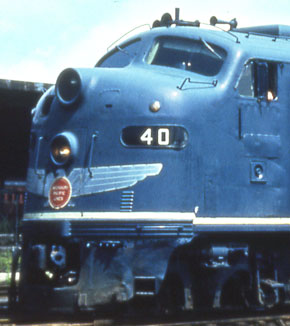 By
the dawn of the 1960s, it had become evident that there was no longer
a need to continue advertising the "Route of the Eagles." As such,
this slogan was discontinued in 1961. Box cars that were purchased new
in 1961-62 as well as repaints received the 42 inch buzzsaw monogram but
the "Route of the Eagles" was gone.
By
the dawn of the 1960s, it had become evident that there was no longer
a need to continue advertising the "Route of the Eagles." As such,
this slogan was discontinued in 1961. Box cars that were purchased new
in 1961-62 as well as repaints received the 42 inch buzzsaw monogram but
the "Route of the Eagles" was gone.
By 1964 the image of the eagle locomotives temselves were changing. Out with the highly eye-catching blue and gray with cream yellow trim and in with the utlitarian overall blue scheme. Yet in the dieing days of passenger service, some of the repainted units such as the E8's kept their spread eagle nose medallions, right to the bitter end. Though in hindsight it seems to have been all too short, the spread eagle medallions were a familiar sight on the front ends of MoPac's most elite power for almost 40 years.
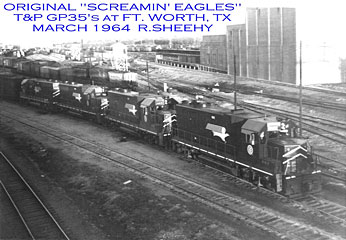 |
|
T&P
GP35s in sparkling new screaming eagle paint at Ft. Worth
in March 1964. As
recounted by Dick Sheehy, who worked in the EMD Service Department
from 1962 to 1966: "During January-March 1964 I was in charge
of the delivery of the first GP35's on the MOPAC system, to the
T&P at their Fort Worth, Texas shops. As I recall, the road
numbers were 600-608. These units were the first EMD turbocharged
units on the MOPAC system and also the first to have the Screaming
Eagle logo on their sides."
The large white eagle applied to the long hoods, aka the 'screaming eagle' and 'turbo-eagle', would become a distinct new symbol of the company during the diesel era, and was eventually integrated into the company logo by the mid and late 1970's. - R. Sheehy Photo |
Screamin'
Eagles
The second version of the classic
MoPac eagle appeared as passenger rail waned on railroads across the country,
and the original Eagle passenger streamliners were being phased-out
on the system. In January 1964 the first GP35 was delivered to the company,
the first of MoPac's "second-generation" diesels. The new all-blue turbo-charged
units were delivered with a striking profile of a speeding white eagle
in flight, which literally dominated the unit's sides. The new variation
was to be applied on all turbo-charged units (there were a few non-turboed
exceptions) with the latest blue locomotive paint scheme and the emblem
earned the nicname "Turbo Eagle" or "Screaming Eagle"
 |
|
Screaming
Eagle from the side of an SD40.
|
 |
Not every unit that recieved the turbo eagles were in fact turbo-charged. Likewise, not every turbo-charged locomotive recieved the turbo eagle. The GP28 like most all of the MOP's Geeps came without turbos (the GP35 class was the exception), but these units, as well some of the GP38 and a GP38-2 and or two somehow slipped by regulations and came out of the paintshops in the scheme. None of MoPac's covered wagons which survived into the Jenk's Blue era, even models such as the turbo-charged ALCo FA1, ever would wear the large white eagle on their sides. Though ALCo's first attempts at turbos didn't really work well, there's no apparent reason for this exclusion... it's interesting to picture what one would have been like.
Notable among
the Screaming Eagle schemes were the units commemorating the Bicentennial
of the United States in 1976, a practice that many roads participated
in. It was especially appropriate since the MoPac was to be among the
host roads of the special train to tour across the country.
 |
|
Scan of the original artwork used in the production of the MoPac's Bicentennial scheme. Daryl W Favignano, (MPRR 1974-1986) who worked in the Mechanical Engineering Dept. at St Louis, was the one who drew up the paint scheme for MP 1776-1976. - Daryl Favignano Collection See MOPAC BICENTENNIAL UNITS for more. |
In late 1975 it was decided
to present two units dressed in red, white and blue. The one-time scheme
on these units would display a large blue eagle with an American flag,
stars and banner, designed by the MoPac Mechanical Engineering Department
at St Louis and the Mechanical Engineer Daryl W. Favignano (MPRR 1974-1986).
MoPac was able to succesfully incorporate it's popular "screaming
eagle" scheme into the special bicentennial livery.
The two units
selected were to be numbered MP 1976 and 1776 appropriately enough. As
luck would have it, the original 1776 was not in any condition for such
a public exhibition, lacking the modern "chop-nosed" cut down hood treatment.
C&EI 84, however was in good condition, mechanically and appearence-wise,
with the low hood only applied since 1975. It quickly was reassigned as
MP 1776. Both Geeps came out of the paintshop in their new livery in February
1976. The 1776/1976 scheme was among the most eye-catching of all the
bicentennial units (some 30 or so railroads participated)... but then
this author is a slight bit biased!
Another favorite scheme seen on MoPac locomotives was the hybrid Double
Eagles scheme when the new company Flying Eagle Buzzsaw logo (see
article below) was applied to units still wearing the large Turbo Eagle.

Diesel Units delivered with the turbo-eagle on long hood (all turbo charged):
- First - T&P #600 (GP35, 1/64)
- Last - C&EI #3162 (SD40-2,
3/74. The final unit of the same order, #3163, was the first to wear
large number scheme)
Diesel Units with the turbo-eagle on long hood which were not turbo-charged (exceptions):
- KO&G #701/T&P #2001/MP #2001 (GP28, delivered w/ eagle, repainted in large number scheme)
- MP #577/#2007 (GP38)
- MP #1976 (GP18, Bicentennial scheme, 1976)
- MP #1776 (GP7, Bicentennial scheme, 1976)
 |
Symbol
of a Mighty Road
The final version appeared in the mid to late 1970's. The latest eagle
was sized to fit over
the classic Missouri Pacific Lines logo. The familiar white "Screaming
Eagle" (with some slight
variations) was superimposed
on the buzzsaw, the "Missouri Pacific Lines" name was eliminated (the
other "Lines": T&P, C&EI and M-I, had all been merged
into the Mopac, essentially becoming one railroad) and the word "Mopac"
was stenciled directly under the Eagle's beak
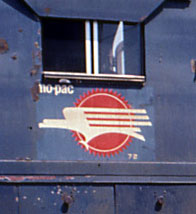 |
The new emblem was applied on the cab under the engineer's and fireman's windows. Called the Flying Eagle Buzzsaw, this new emblem actually first appeared on a company newsletter in 1969. As the new logo was applied to locomotives, the elimination of the larger Screaming Eagle on the sides began, with large numbers applied in it's place. There are exceptions here as well with quite a number of units having both eagle emblems, in a "hybrid" scheme. Lastly the eagle buzzsaw was to be seen on the newest and shopped cabooses as well as freight cars by 1978 and applied until the Union Pacific takeover.
Strange
How Fate can be Sometimes...
Years after the Union Pacific
merger of MoPac and the last blue unit, GP38-2, left the system in 1994,
another set of wings are now making a come-back -- this time on the newest
power appearing on the Union Pacific system. Of course this is a ressurection
of the classic the UP shield accentuated by spread wings, but one can
imagine how fitting these engines would appear if the shield were a buzzsaw
and the Armour Yellow was a freshly applied coat of Eagle Blue?
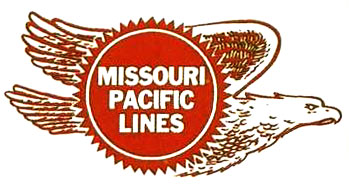 |
 |
|
Passenger cars carrying the Eagle name comprises a hefty list. These cars were owned by the Missouri Pacific, Texas & Pacific and the International-Great Northern. Sleeping Cars:
Head-End Car:
Coaches:
Sleeping cars:
There were a number of major routes that made up the whole Route of the Eagles service, including:
|
||||||||||||||||
![]()
Dates of Drawings for the Eagle medallion used on the front of Missouri Pacific E units
Compiled by G. Semon, from MoPac Group
MoPac Dwg GL-24159 Emblem, Locomotive End Dated 8-7-39
Used on 7000 & 7001.
EMD 8048628 Medallion Dated 8-10-39 First used Missouri Pacific Lines
EMD 8097526 Medallion & Wing Design Dated 4-20-45 Used on Eng. 7004
Original for Engine 7004 which used painted on front Eagle Medallion.
Replaced by EMD Dwg 8109682. First used on E-641 MoPac Passenger Locomotive.
EMD 8109682 Assembly Missouri Pacific Etched Medallion Dated 12-27-45
First used on E-716
EMD 81090410 Assembly Texas & Pacific Etched Medallion Dated 1945
Used on T&P 2000-2009 and T&P 2010-2017
![]()
Eagle Buzzsaw from caboose.
Sources: Route of the Eagles - Missouri Pacific in the Streamlined Era, by Greg Stout
Ed Hawkins, Jim Ogden, Gene Semon, - MOPAC Group
| All images & text © 2000-2008 T. Greuter / Screaming Eagles, unless otherwise noted. All Rights Reserved. | |













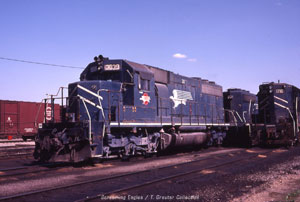
 Eagle
Facts
Eagle
Facts 




